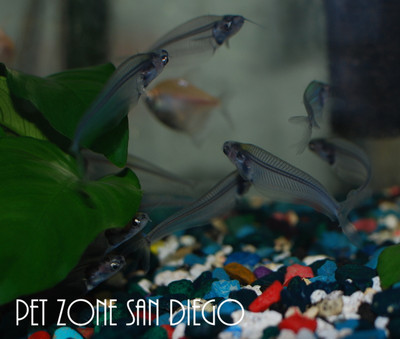Revealing the Elegance of the Ghost Glass Catfish: An In-depth Exploration
Posted by Max Gandara on on 23rd Apr 2024
Revealing the Elegance of the Ghost Glass Catfish: An In-depth Exploration
In the serene world of freshwater aquariums, few fish possess the ethereal beauty and grace of the Ghost Glass Catfish (Kryptopterus vitreolus). With its translucent body and enigmatic presence, this species adds a touch of mystique to any aquatic environment. In this detailed article, we embark on a journey to unravel the captivating allure of the Ghost Glass Catfish, delving into its physical characteristics, care requirements, and unique attributes.
Physical Characteristics: The Ghost Glass Catfish is renowned for its transparent body, which allows its internal organs, including the skeleton and digestive tract, to be visible. This remarkable feature gives the impression of a ghostly apparition gliding through the water, hence its name. Despite its translucent appearance, faint outlines of its internal organs and a silvery sheen can be observed under the right lighting conditions.
Apart from its transparent body, the Ghost Glass Catfish possesses a slender, elongated shape, with a forked tail fin and delicate fins that contribute to its graceful silhouette. Its lack of pigmentation and subtle coloration make it a versatile addition to a variety of aquascapes, complementing both minimalist and densely planted setups.
Behavior and Temperament: Ghost Glass Catfish are known for their peaceful and shoaling behavior, making them ideal inhabitants for community aquariums. In their natural habitat, these fish are typically found in large groups, where they forage for food and seek safety in numbers. In the aquarium, they exhibit similar behavior, often forming tight-knit shoals that gracefully glide through the water column.
Despite their peaceful nature, Ghost Glass Catfish may become stressed or vulnerable if kept in small numbers or with aggressive tank mates. Therefore, it is recommended to keep them in groups of five or more individuals to promote natural shoaling behavior and alleviate stress.
Habitat and Tank Requirements: Creating an optimal environment for Ghost Glass Catfish is essential for their well-being and longevity. In the wild, they inhabit slow-moving rivers, streams, and flooded forests with dense vegetation and plenty of hiding spots.
In captivity, a well-planted aquarium with subdued lighting and gentle water flow mimics their natural habitat and provides ample opportunities for exploration and shelter. A tank size of at least 20 gallons is recommended for a small group of Ghost Glass Catfish, although larger tanks are preferable for accommodating larger groups and providing more swimming space.
Maintaining stable water parameters is crucial for the health of Ghost Glass Catfish. They prefer slightly acidic to neutral water with a pH range of 6.5 to 7.5 and a temperature between 75°F to 82°F (24°C to 28°C). Additionally, providing efficient filtration and regular water changes are necessary to ensure optimal water quality.
Dietary Needs: Ghost Glass Catfish are omnivorous and have a varied diet in the wild, feeding on a combination of small invertebrates, algae, and organic detritus. In the aquarium, they readily accept a diverse diet of high-quality sinking pellets, flakes, freeze-dried or frozen foods such as bloodworms, brine shrimp, and daphnia.
Feeding should be done once or twice daily, offering a combination of sinking and floating foods to ensure all individuals have access to nutrition. Additionally, providing vegetable matter, such as blanched zucchini or cucumber, helps supplement their diet and promote optimal health.
Compatibility: Ghost Glass Catfish are peaceful and compatible with a wide range of tank mates, including small to medium-sized community fish such as tetras, rasboras, and peaceful catfish species. However, caution should be exercised when housing them with larger or more aggressive species that may intimidate or outcompete them for food.
While Ghost Glass Catfish are social and thrive in the company of their own kind, they can also coexist peacefully with other bottom-dwelling species. Keeping them in groups of five or more individuals helps alleviate stress and encourages natural shoaling behavior.
Breeding: Breeding Ghost Glass Catfish in captivity is challenging and rarely achieved in home aquariums. Unlike many other freshwater species, they do not readily spawn in the home aquarium, and successful breeding often requires specialized conditions and hormonal induction.
Despite the challenges, dedicated hobbyists have successfully bred Ghost Glass Catfish in controlled environments, typically by simulating the conditions of their natural habitat and providing optimal water quality. However, most Ghost Glass Catfish available in the aquarium trade are commercially bred specimens.
The Ghost Glass Catfish is a captivating and ethereal species that brings serenity and beauty to any freshwater aquarium. With its transparent body, peaceful demeanor, and shoaling behavior, it adds a touch of mystique to aquatic environments. By providing it with a suitable environment, a varied diet, and the company of its own kind, enthusiasts can enjoy the beauty and allure of the Ghost Glass Catfish for years to come.

